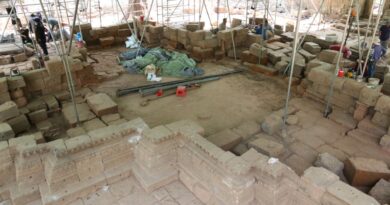កាលពីពេលថ្មីៗនេះ ក្រុមការងារជួសជុលខ្លោងទ្វារតាកាវ នៃក្រុងអង្គរធំ បានប្រទះឃើញដុំថ្មមានរូបចម្លាក់អប្សរាសម័យបាយ័ន្តព្រមទាំងថ្មចម្លាក់ផ្សេងទៀតនៅផ្នែកខាងជើងស្ពានហាលនៃខ្លោងទ្វាតាកាវ ក្រោយពេលគេបានសម្អាតរុក្ខជាតិ និងកាយកំណកដីដែលបានលុបលើរចនាសម្ពន្ធផ្នែកខាងក្រោមនៃស្ពានហាលជាយូរឆ្នាំមកហើយ។ លោកស្រី គឹម សេងភក្តី បុរាណវិទូបានឱ្យដឹងថា បំណែកថ្មដែលមានរូបចម្លាក់អប្សរា និងក្បាច់ចម្លាក់លម្អផ្សេងៗ ត្រូវបានគេយកមករៀបធ្វើជាជញ្ជាំងខាងជើងនៃស្ពានហាល។
លោកស្រីបញ្ជាក់ថា រូបចម្លាក់អប្សរាទាំងអស់នេះមានលក្ខណៈដូចគ្នាទៅនឹងរូបចម្លាក់អប្សរានៅតាមសរសរប្រាសាទបាយ័ន្ត រីឯចម្លាក់ថ្មដទៃផ្សេងទៀតមានរូបរាងដូចគ្នានឹងចម្លាក់ដែលលម្អលើរចនាសម្ពន្ធនៃសំណង់ខ្លោងទ្វារតាកាវ។
ជាជំហានដំបូង លោកស្រីសន្និដ្ឋានថា ទី១ បំណែកថ្មដែលមានរូបចម្លាក់ទាំងនេះប្រហែលជាត្រូវបានសាងសង់ដំណាលគ្នានឹងខ្លោងទ្វារ និងប្រាសាទបាយ័ន្ត ដោយយកថ្មពីប្រាសាទបាយ័ន្តយកមកបំពេញចំណុចខ្វះខាតនៅស្ពានហាលនេះ ព្រោះរូបចម្លាក់អប្សរាស្ថិតក្នុងរចនាប័ទ្មបាយ័ន (ចុងស.វ.ទី១២ និងដើមស.វ.ទី១៣)។ ទី២ ស្ពានហាលនេះ អាចមានការសាងសង់បន្ថែមនៅដំណាក់កាលណាមួយដោយបានរុះរើយកថ្មពីប្រាសាទបាយ័ន្តមកប្រើប្រាស់?។
ជាជំហានបន្ទាប់ ក្រុមអ្នកបុរាណវិទ្យានឹងធ្វើកំណាយស្វែងរកថ្មរូបចម្លាក់ទេវតាជាច្រើនដែលបានធ្លាក់ចូលទៅក្នុងកសិន្ធុផ្នែកខាងជើងនៃស្អានហាល ដើម្បីយកថ្មចម្លាក់ដែលកប់បាត់នៅក្នុងដីទាំងអស់នោះមកជួសជុលនិងរៀបដាក់ទៅតាមទីកន្លែងដើមវិញ។ យោងតាមការរកឃើញដុំថ្មមានចម្លាក់អប្សរាដូចនៅប្រាសាទបាយ័ន្ត នៅតាមជញ្ជាំងដែលជាគ្រឹះរូបទេវតាបាននាំឱ្យមានចម្ងល់១ ថាតើចម្លាក់ទេវតានិងយក្សទាញព្រ័ត្រនេះសង់នៅពេលណា? សូមអ្នកសិក្សាស្រាវជ្រាវជួយពិចារណា៕
អត្ថបទ៖ កញ្ញា ឆាយ ផាន់នី
រូបភាព៖ លោក យី សុថា
Archaeologists from the APSARA National Authority found the pieces of Apsara carvings on the northern wall of the causeway of Takav Gate.
Recently, the Takav Gate restoration team found the stone carvings with the Bayon style Apsara as well as other stone carvings on the northern wall of the causeway of Takav Gate after clearing the vegetation and removing soil from the lower structure of the causeway. Archaeologist Kim Sengpheakdey said that pieces of stones with Apsara carvings and other decorative sculptures were used as the northern wall of the causeway.
She added that these Apsara carvings are similar to the Apsara on the pillars of the Bayon temple, while other stone carvings have the same shape as the ones that decorated the structure of the Takav Gate.
As a first step, she concluded that firstly, the stone fragments containing these carvings may have been built simultaneously with the gate and the Bayon temple, using stones from the Bayon temple to fill in the gaps in the causeway, because the Apsara carvings are in Bayon style (late 12th century and early 13th century). Secondly, this causeway can be further constructed at any stage by removing the stones from the Bayon temple to use.
As a next step, archaeologists will do the excavation to find the Deva statues that fell into the moat in the north of the causeway to restore them to their original position. The discovery of the stone carvings with the Bayon style Apsara on the wall was used as the foundation of the Deva balustrade bringing up a question for researchers to seek the answer to when the ASURA and DEVAS’ balustrades were constructed?
Article: Miss Chhay Phanny
Photos: Mr. Yi Sotha





